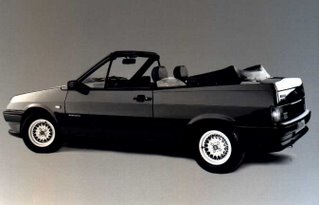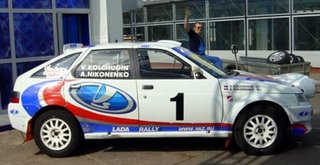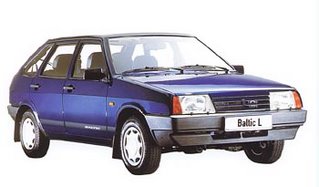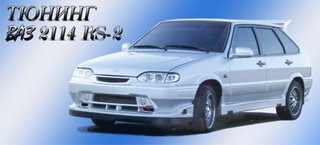






The Lada Samara was a Soviet automobile produced from 1984 until 2004. The brand name Samara originally was used only for exported models, in Russia the same model was called "Sputnik". The Samara was to build on the success of the traditional Riva range, by providing a car that combined a robust build and ease of maintenance with a modern style. It was produced in various three, four and five door designs with engine displacements 1.1, 1.3 and 1.5 litre petrol engines. Lada had hoped that the Samara would enable it to compete for sales in the mainstream western car market.
It was named after the city of Samara, Russia. Typical of its sales in Western Europe, the car was sold in the UK from 1987 until all Ladas were withdrawn from the British market in 1997. Despite the involvement of Porsche engineers in tuning the engine, the Samara never achieved the same success as the Riva in western Europe, even though it did prove to be a robust car with a modern style and a competitive price. Even so, it suffered from variable and often doubtful build quality and some of the uglier handling qualities that had always been associated with Lada. The car's plastic front grille was also a point of contention, as it was often seen to be ugly and cheap-looking; many were replaced with aftermarket grilles, even by Lada dealers themselves before the cars were sold.In the UK, the Samara achieved only small market penetration, with sales restricted mainly to a limited demographic group - older male drivers, living in the North of England, working class and willing to undertake basic maintenance on a 'DIY' basis. This market sector is that which Lada had always served, and many buyers in the sector preferred to stay with the Riva. The whole idea behind the introduction of the Samara is that it would make sales to a wider clientele (those who wanted up-to-date technology), and this it failed to do.
One notorious feature of early Samaras was the 'disco-lights' problem caused by poor electricals. The Samara driver had to be aware that when he applied the brakes, it was quite likely that the hazard and reversing lights would come on and not the brake lights. That said, for the motorist who could handle it, the Samara provided very cost effective mobility. The car was cheap, easy to maintain on a DIY basis, robust and some of its design features were distinctly up-market. For example, models made for sale in the UK market were fitted with an excellent German audio system and a useful sun roof. In its last year in the UK, by which time build quality had indeed become much better, a fuel injected Samara version was sold which gave very sporty performance.
After 1997 the Samara was mostly sold in its homeland only, although it was still sold in some foreign markets with less strict emissions regulations. The last Samara rolled off the production line in 2004, ending 20 years of production.
An upmarket version for the European market, the Lada EuroSamara, was assembled in Finland at the Valmet Automotive plant in Uusikaupunki.
It was named after the city of Samara, Russia. Typical of its sales in Western Europe, the car was sold in the UK from 1987 until all Ladas were withdrawn from the British market in 1997. Despite the involvement of Porsche engineers in tuning the engine, the Samara never achieved the same success as the Riva in western Europe, even though it did prove to be a robust car with a modern style and a competitive price. Even so, it suffered from variable and often doubtful build quality and some of the uglier handling qualities that had always been associated with Lada. The car's plastic front grille was also a point of contention, as it was often seen to be ugly and cheap-looking; many were replaced with aftermarket grilles, even by Lada dealers themselves before the cars were sold.In the UK, the Samara achieved only small market penetration, with sales restricted mainly to a limited demographic group - older male drivers, living in the North of England, working class and willing to undertake basic maintenance on a 'DIY' basis. This market sector is that which Lada had always served, and many buyers in the sector preferred to stay with the Riva. The whole idea behind the introduction of the Samara is that it would make sales to a wider clientele (those who wanted up-to-date technology), and this it failed to do.
One notorious feature of early Samaras was the 'disco-lights' problem caused by poor electricals. The Samara driver had to be aware that when he applied the brakes, it was quite likely that the hazard and reversing lights would come on and not the brake lights. That said, for the motorist who could handle it, the Samara provided very cost effective mobility. The car was cheap, easy to maintain on a DIY basis, robust and some of its design features were distinctly up-market. For example, models made for sale in the UK market were fitted with an excellent German audio system and a useful sun roof. In its last year in the UK, by which time build quality had indeed become much better, a fuel injected Samara version was sold which gave very sporty performance.
After 1997 the Samara was mostly sold in its homeland only, although it was still sold in some foreign markets with less strict emissions regulations. The last Samara rolled off the production line in 2004, ending 20 years of production.
An upmarket version for the European market, the Lada EuroSamara, was assembled in Finland at the Valmet Automotive plant in Uusikaupunki.





No comments:
Post a Comment